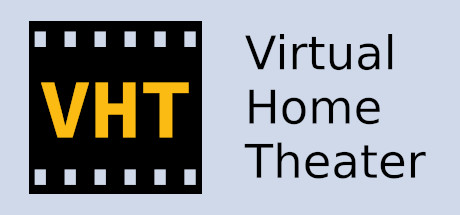About This Software
Virtual Home Theater (VHT) is a video player, an audio player and a desktop mirroring software that simulate the audio channels from a media file as virtual sound objects or virtual speakers, delivering true 3D spatial audio in VR, replacing the old “head-locked” stereo audio technology.
The demo version has all the features of the purchased version, except that the utilization duration for each media file playback and desktop mirroring is limited to few minutes.
With Virtual Home Theater you can:
– watch 2D or 3D movies (up to 8K (7680×7680)@60fps, 4K@120fps, 10-bit, YUV 4:2:0) on a virtual big screen with virtual audio speakers (stereo, 5.1, 7.1, etc.) and subtitle
– listening to stereo, 5.1 and 7.1 surround channels music as on a real audio home theater system
– listening to ambisonics audio
– watch VR videos in 180°, 200° fisheye and 360° format
– play non-VR games with virtual 5.1 surround audio (also in stereo Side-by-Side mode if the game support it), browsing or watching a media stream on a virtual desktop big screen with your default Windows audio device mirrored as virtual audio speakers inside of VHT
It is recommended to use a quality flat-response studio/monitor headphones for a good audio soundstage.
Some of the main features are:
– HRTF-based 6 DoF real time binaural sound scene rendering for multiple sound sources and listener’s head orientation (roll, pitch, yaw) and position (x, y, z)
– 200° FoV Fisheye VR videos (MKX200 and MKX22 lens support or any FoV possible lens type in mono, stereo or 360° format)
– VR 180° front dome, 360° sphere Equirectangular (EQR) and Equiangular cubemap (EAC) video mapping/projection
– multiple audio and video formats support [3]
– multiple 3D video formats
– support hardware video decoding playback up to 8K(7680×7680)@60fps, 4K@120fps, 10-bit, YUV 4:2:0
– support software video decoding up to 8K(7680×7680), 10-bit, YUV 4:4:4
– support BT.601, BT.709 (sRGB), BT.2020 and DCI-P3 color space (auto sellection or manual overide)
– gamut mapping to BT.709, DCI-P3 or to the HMD’s color gamut
– display video’s native frame rate up to the HMD’s frame rate
– up-sampling the video’s native frame rate to the HMD’s refresh rate by using frame interpolation
– smooth-playback capability to reduce flicker, judder and stutter for videos with different fps than the VR headset’s fps
– video image filters (sharpen, etc.) and color correction
– support first-, second- and third-order ambisonics in the AmbiX and FuMa formats
– ambisonics + head-locked stereo audio format playback
– multiple HRTFs selections to match your head auditory characteristics
– 32 audio channel masks (simulated as virtual speakers, mirroring the audio output channels from played media’s audio track)
– 27 audio channel layouts for non-ambisonics audio: mono, stereo, 2.1, surround, 5.1, 6.0, 7.1, Hexadecagonal (16 audio channels), etc…
– use a lower or higher order ambisonics fields (virtual speakers layouts) to play an ambisonics audio
– playback support for recorded binaural audio track
– change the virtual speakers position
– use your preferred headphones by selecting a different audio output device
– subtitles: internal (bitmap, text) and external (.srt, .idx)
– track selection for audio, video and subtitle
– Unicode font support for non-Latin character used for subtitle and for media folder/file name
– support access to network shared folders from a NAS (Network Attached Storage) system
– azimuth, zoom level and objects apparent size change for 180° and 360° videos
– change the audio offset azimuth from video image for 360° videos
– play a Network Stream from a direct URL to media
– have a ‘sneak peek’ of your PC desktop (e.g. for internet browsing) when you watch a movie or listening to music within VHT
– desktop mirroring will mirror (show inside of VHT) your PC desktops screens (limited to the number of physical displays connected to your main GPU)
– desktop mirroring will mirror (simulate inside of VHT) your Windows default audio device channels output (no need to have real speakers connected to your PC) as virtual speakers
– play a non-VR 3D game in stereoscopic mode (Side-by-Side or interlaced) if the game support it
– virtual speakers layout and video screen re-position for a more comfortable experience in any sited position (e.g. lying on bed)
– show in real time a 3D surface or volumetric graph representation of sound waves pressure amplitude propagation from each virtual speaker
– designed to render the media’s video original encoded picture quality and format without degradation (original resolution, picture details, colors and frame rate)
– designed to render the media’s audio track original encoded sound quality and layout without degradation or enhancements, as intended by media creator
– optimized code for speed and low installation folder size (40 MB)
– support for hybrid graphics systems
Benefits of Virtual Home Theater over the real home theater system:
– is less expensive
– you don’t need to build it
– you can change position, size and shape of the screen
– you can change position of the virtual audio speakers
– no need to do a real mic calibration for your audio system
– high contrast and wide color gamut due to OLED technology used for some HMD displays
– no disturbed neighbors
– no heavy equipment to carry with you if you change your home location
– environment friendly due to less energy consumption than a complex audio/video system equipment
– other family members can enjoy their normal activity in the same room (no need to turn off the lights or lower the audio volume)
– no sound attenuation by obstructions
– no sound denaturation by walls reflections
– you can experience ambisonics audio

